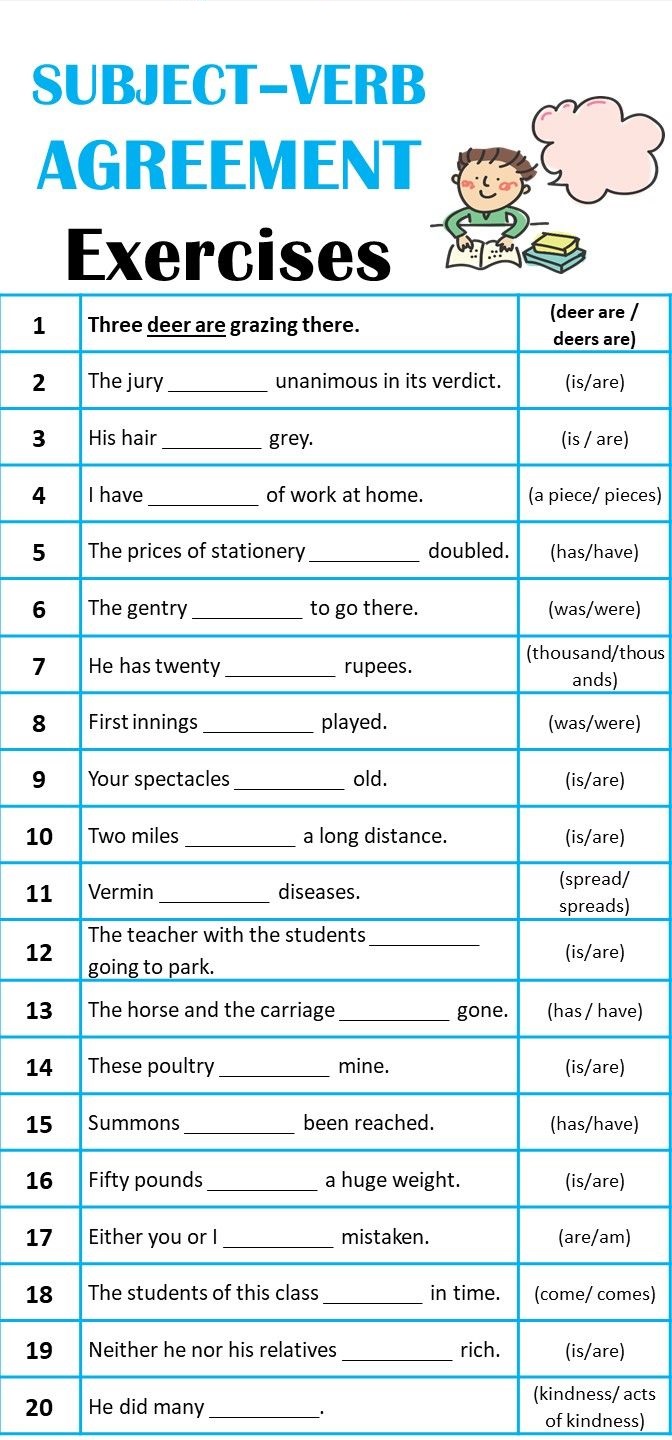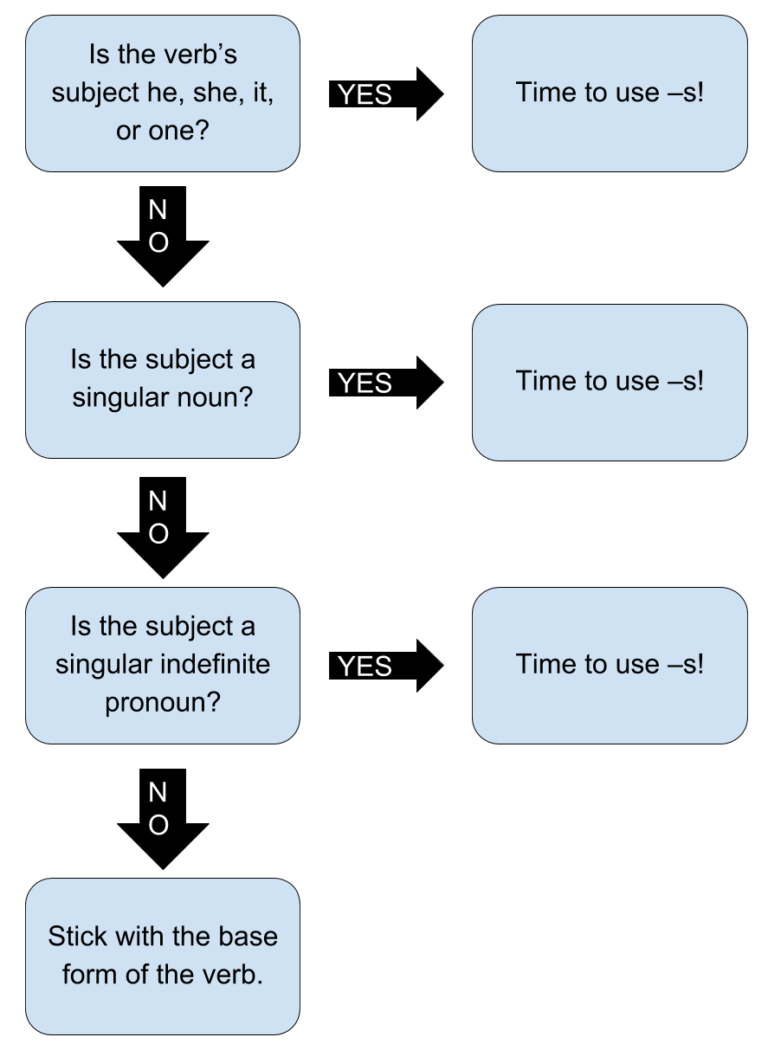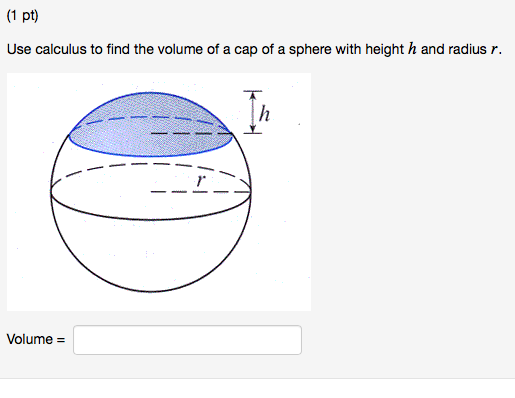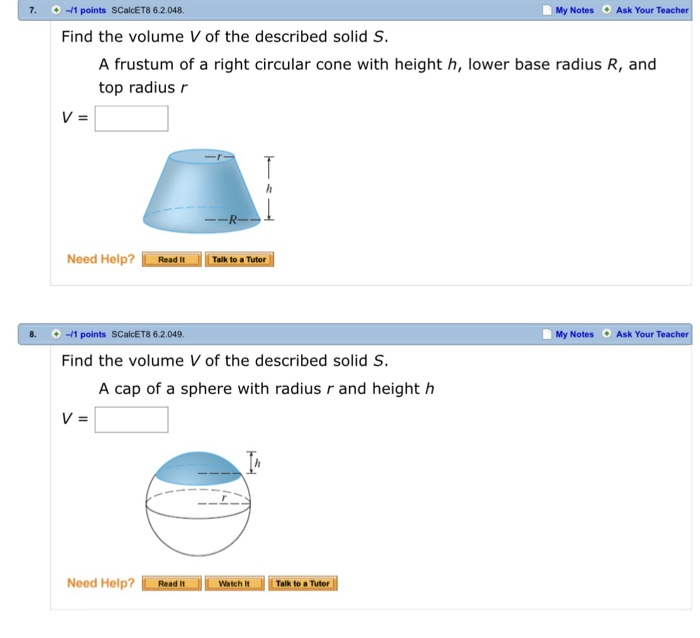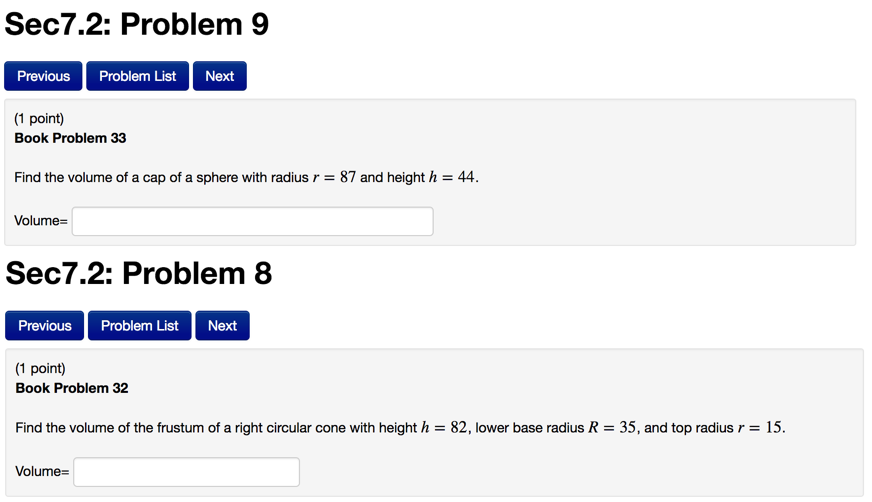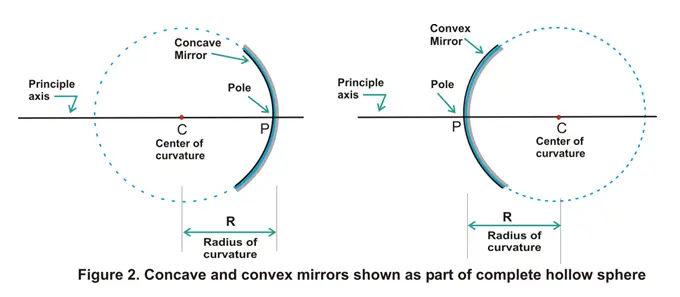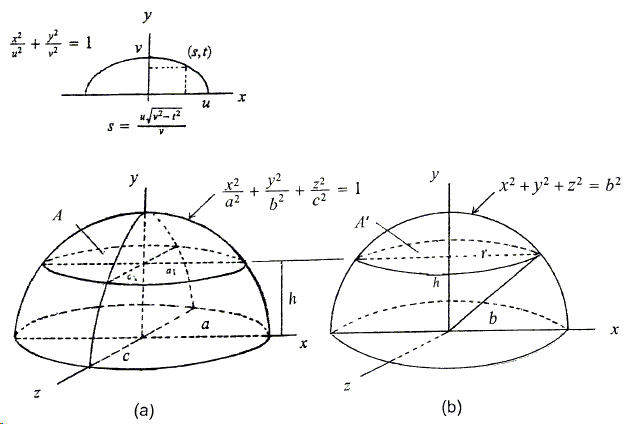As stated before, the first person singular form of a regular verb form or to-be verb form is often the same as the simplest form of the verb. However, that's not always true with irregular verbs and words in the to-be form, such as was or were. Look below to continue learning about the other subject forms and examples of their verb conjugation English use. It is also common to use do, does and did as auxiliary verbs together with another verb in its base form. This is used to create negative sentences, questions, or for adding emphasis. "Do" and "does" sentence examples are a great way to begin learning about the verb "to do." Some forms of "do," including "does," are examples of helping verbs in English.
These kinds of verbs extend the meaning of the main verb in a sentence. Before you compare "do" and "does," it helps to understand verb tenses. Look at each tense and note how the suffixes change a regular verb form during standard conjugation. For this example, we'll use first person singular form, I. The past participle is used for the perfect tenses. In regular verbs, it's the same as the simple past tense, so there's nothing extra to learn.
However, irregular verbs often use unique past participles, so you may have to memorize their forms. Are a special kind of helping verb that do not show tense and do not follow subject/verb agreement. They do not add 's' in the third person singular . They are used to show possibility, probability, and necessity. Like other helping verbs, modals are always followed by a second verb. But the second verb must follow a different conjugation pattern if a modal is present.
The second verb can never add -s, -es, -ed, or -ing. It also cannot be in the infinitive form (to...) or in the gerund form (...-ing). Auxiliary verbs, or "helping verbs," are used in English to change another verb's tense, voice, or mood. When auxiliary verbs are used, there's always a main verb that represents the main action. However, the auxiliary verb must still be conjugated correctly. As you can see, among all the subject matches with all the regular verb conjugations the only change occurs with the third person singular form.
This is the standard pattern with regular verb forms like to work, making this English verb conjugation easy to remember. Our final group of irregular verbs are in some ways the easiest, and in others the hardest ones to learn. The simple side is that each form is different so we will not become confused between the base form, the past simple and the past participle.
Depending on which version of the verb is used, we will know how it is being employed. However, because there are three different forms of the verb (plus, of course, the gerund, or 'ing' form) there are more words to learn. For our example here, we will use the verb with the base form 'write'. Well, not really very much because verbs are the words that describe the actions that we do. English verbs can take two main forms, regular verbs and irregular verbs. They are the subject of this article, and are a crucial part of the language as we study how to learn English grammar online.
Helping verbs, also called auxiliary verbs, are helpful verbs that work with other verbs to change the meaning of a sentence. A helping verb combines with a main verb in order to accomplish different goals. These include changing the tense of the verb or altering the mood of a sentence. In this example, "Have" is the auxiliary verb and "been" is the main verb. It is important to understand that the auxiliary verb doesn't mean anything but helps the verb "to be".
Have shows that this is the present perfect tense. An auxiliary verb extends the main verb by helping to show time, tense, and possibility. Our last type of verb isn't actually a verb at all—sorry about that!
However, infinitives look a lot like verbs because they are derived from them. An infinitive of a verb is identical to the base form of the verb. For example, the infinitive form of the verb open is open.
Typically, we use infinitives with the word to in order to form infinitive phrases. Infinitive phrases can be used for a variety of reasons, such as to act like nouns, adjectives, or adverbs. The opposite of a transitive verb is an intransitive verb. A verb is an intransitive verb if it is not used with a direct object.
Remember, only nouns, pronouns, and noun phrases can be direct objects. Prepositional phrases, adjectives, and adverbs cannot be used as direct objects. Once again, both action and stative verbs can be used as intransitive verbs. As an auxiliary verb do is used with a main verb when forming interrogative or negative sentences, or for adding emphasis. It is also called the dummy operator or dummy auxiliary. Do is one of the most common auxiliary verbs in English and it can be difficult for students because you often do not use this in your own language.
We use do/does to make a question or a negative except with be, will and modal verbs. As you can see, the auxiliary verb "to be" helps us to understand if something is in the passive voice or if it is a progressive/continuous verb tense. We use different auxiliary verbs to help main verbs and give them more meaning. For example, we can use "do" to help us understand that a sentence is a question or a negative. You already know quite a lot about how to get verb forms to agree with the subject in a sentence.
If you're learning English as a second language, you may wonder about imperfect verb conjugation. They do not learn the present participle and 3rd person singular present simple for regular or irregular verbs for another very simple reason - they never change. Are verbs that are used in a verb phrase to show tense, or form a question or a negative. Helping verbs are used to show the perfect verb tenses, continuous/progressive verb tenses, and passive voice.
Helping verbs are always followed by a second verb. When we write sentences or clauses, we need to include a verb. A verb is a word that we use to refer to actions and states of being . For example, the words describe, eat, and rotate are verbs. As you are about to see, verbs come in a lot of different types that don't all behave the same way.
When using proper grammar, it is important that you use verbs correctly. So, we are going to explore the many different types of verbs that we use and how to successfully use them to create great, clear sentences. Future perfect continuous tense functions just like the future perfect tense, except with an ongoing action. Both, however, are frequently used with expressions of time. The auxiliary verb do is used to make questions and negative sentences in the simple present tense.
The sentence "I was dancing" would be replaced with "I danced" in Spanish. Note that other words that end in y will have different endings, such as pray becoming prayed, or lay becoming laid. That's because many irregular forms have their own unique verb conjugation patterns.
These are irregular verbs which have different English verb conjugations, such as these examples. Each of these different tenses in English verb conjugation describe an action taking place at different times. In standard verb conjugation English use, present events occur right now, like in I or are ongoing. The past events occurred in the past, some of which are ongoing. You also have the future, which explains that actions will happen in the future, many of which will continue further into the future. You complete the verb conjugation of these tenses by adding an -ed, -ing, and often a linking word.
Shouldmustought tosemi-modal verbsneeddareused to We use the word "form" to mean the "shape" or "writing" of the actual verb itself. We use the different verb forms to make the tenses and other verb structures, but they are not the same thing. We use modal helping verbs to change the "mood" of the main verb. Do as an auxiliary verb is used to form thenegativeand interrogative sentences of other verbs. It is also used in an affirmative sentence to give emphasis. In its negative form (don't), it can function as negative imperative but only in the present tense.
Auxiliary use - You can only use modal verbs as auxiliary verbs, in order to modify the meaning of the main verb. Simple present tense is used for actions that happen regularly or things that don't change, such as preferences or opinions. It's made with the root form, unless the subject is third-person singular , in which case you use the third-person singular present form.
Below, we explain how to conjugate each of the main tenses in the present, past, and future. Keep in mind that irregular verbs may use different forms. They do not work as verbs in the sentence rather they work as nouns, adjectives, adverbs, etc.
Non-finite verbs do not change according to the number/person of the subject because these verbs, also called verbals, do not have any direct relation to the subject. Conjugation gives your reader or your listener important background information. In the examples above, you saw how to use words to describe the number of people or things someone's talking about in verb conjugation English subject placement. You also saw examples of how you can tell when an action will occur in verb conjugation English tenses. Additionally, verb conjugation also explains how much of an action has taken place, the gender of the people that receive an action, and the mood of an overall sentence.
Again, this action word is the same as the root of the infinitive form that we will change during the conjugation of verbs in other tenses. This will be highlighted later in the guide to reflect tense change in English verb conjugation. Let's look at the regular verb to work as an example. The infinitive form of this action verb is to work. During verb conjugations it will change from the infinitive form depending on the grammatical subject. This means that you add different suffixes to the infinitive form depending on who you're referring to in a sentence.
Unlike action verbs, stative verbs refer to conditions or states of being. Generally speaking, we use stative verbs to describe things like qualities, states of existence, opinions, beliefs, and emotions. When used in a sentence, stative verbs do not refer to actions. It is important to know that some verbs can be used as either action or stative verbs depending on their meaning in the sentence.
We are less likely to use stative verbs in the continuous verb tenses. The verb forms of be, do, and have can be used either as a main verb or an auxiliary verb. The following examples show these verbs used as auxiliary verbs.
Do can be used as main verb and as auxiliary verb. Do as an auxiliary verb is used to form the negative and interrogative sentences of other verbs, as well as for emphasis and negative imperatives. One of the more complicated tenses in English, the perfect continuous tense combines the perfect and continuous tenses at the same time.
It's largely used like the perfect tense, but with ongoing or continuous actions. But first, you'll want to learn the standard verb forms of the majority regular verbs below. The phrases do so and do what for questions are pro-verb forms in English. They can be used as substitutes for verbs in x-bar theory grammar to test verb phrase completeness.
Bare infinitives forms often are used in place of the missing pro-verb forms. Past perfect continuous tense is used in complex and compound sentences to show which event happened first. While the past perfect tense describes an individual action, the past perfect continuous shows an ongoing action that is already finished.
Are irregular verbs, so you have to pay close attention to using their right forms even when they're not the main verb. In the past tense Didn't is used to make a negative sentence for all subjects (I / you / we / they / he / she / it). This is for regular AND irregular verbs in English.
Being— Being is the present participle of the verb to be. You will mainly see it in continuous tenses and as a subject in sentences ("Being a polyglot is a great asset."). Sometimes we use these verbs as main verbs and auxiliary verbs which can seem confusing but if you understand how they work as auxiliaries then you should understand. Linking verbs work as main verbs in the sentence, but auxiliary verbs help main verbs. So creating past participle from regular verbs is quite easy. Unfortunately there are also irregular verbs in English which don't follow a fixed pattern.
The best way to do this is to learn them gradually as part of a structured course. This is how students at Wall Street English learn regular and irregular verbs, and it's more practical and fun than trying to memorize a long list. These are irregular verbs where the same form is used in the base, past simple and past participle.







